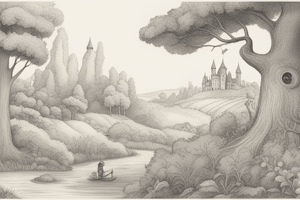Podcast
Questions and Answers
What is the main function of the respiratory system?
What is the main function of the respiratory system?
- To take in oxygen and remove carbon dioxide (correct)
- To digest food
- To circulate blood throughout the body
- To regulate body temperature
The trachea is divided into three branches before reaching the lungs.
The trachea is divided into three branches before reaching the lungs.
False (B)
What are the tiny air sacs in the lungs called?
What are the tiny air sacs in the lungs called?
alveoli
The _____ are lined with cilia and a thick layer of mucus to trap bacteria and dirt.
The _____ are lined with cilia and a thick layer of mucus to trap bacteria and dirt.
Match the following parts of the respiratory system with their functions:
Match the following parts of the respiratory system with their functions:
What happens to the diaphragm when we inhale?
What happens to the diaphragm when we inhale?
Alveoli provide a small surface area for gas exchange.
Alveoli provide a small surface area for gas exchange.
What is the primary reason for the presence of mucus in the bronchi?
What is the primary reason for the presence of mucus in the bronchi?
When exhaling, the diaphragm and muscles of the _____ relax.
When exhaling, the diaphragm and muscles of the _____ relax.
Which of the following statements about the respiratory system is true?
Which of the following statements about the respiratory system is true?
Flashcards
Respiratory System
Respiratory System
The system responsible for taking in oxygen and releasing carbon dioxide from the body.
Airway
Airway
The passageway for air to enter the respiratory system, including the nose and mouth.
Trachea
Trachea
The tube connecting the throat to the lungs, reinforced with cartilage rings to keep it open.
Bronchi
Bronchi
Signup and view all the flashcards
Alveoli
Alveoli
Signup and view all the flashcards
Capillaries
Capillaries
Signup and view all the flashcards
Cilia
Cilia
Signup and view all the flashcards
Mucus
Mucus
Signup and view all the flashcards
Diaphragm
Diaphragm
Signup and view all the flashcards
Inhalation
Inhalation
Signup and view all the flashcards
Exhalation
Exhalation
Signup and view all the flashcards
Study Notes
The Respiratory System
- The respiratory system's role is to take in oxygen and remove carbon dioxide from the body.
- Air enters through the nasal cavity or mouth.
- Air travels down the trachea, a tube with strong rings of cartilage.
- The trachea branches into two bronchi.
- Bronchi further divide into bronchioles.
- The end of the bronchioles have tiny sacs called alveoli.
Alveoli
- Alveoli are the sites of gas exchange.
- Alveoli have a large surface area for efficient gas exchange.
- Alveoli have moist surfaces that allow oxygen to dissolve.
- Alveoli have a thin lining allowing easy diffusion of gases.
- They have a dense network of capillaries, which allows for efficient gas exchange.
- The surface area of the alveoli in both lungs is equivalent to a tennis court.
Breathing Mechanics
- Breathing relies on the muscles in the rib cage and the diaphragm to change the space in the chest cavity.
- Inhalation involves the diaphragm contracting, expanding the chest cavity, and lowering the pressure inside the lungs.
- Air rushes into the lungs to equalize the pressure.
- Exhalation involves the diaphragm relaxing, decreasing the chest cavity space, and increasing pressure inside the lungs.
- Air is expelled as pressure increases.
Studying That Suits You
Use AI to generate personalized quizzes and flashcards to suit your learning preferences.




